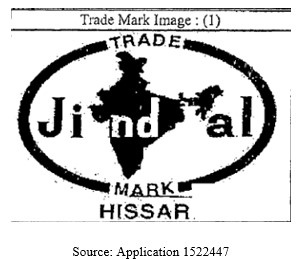If your trademark, device mark or logo mark consists of your country’s national map, then can you register it without the examiner objecting to such depiction? The answer is – Yes. A recent judgement delivered by the Delhi High Court sets the precedent for trade mark applicants wanting to register their device mark but are stuck in a dilemma about its registrability because their mark may contain the national map of India. This blog provides a complete breakdown of this judgement, and explains why, prospective applicants need not worry about this particular objection and how they can overcome such an order from the Registrar if they find themselves in such a situation.
Facts of the case
- The Appellant, Jindal Industries Private Limited, filed this appeal challenging an order passed by the Senior Examiner of Trade Marks on 19th March, 2019 and also the Statement of Grounds of Decision issued by the Senior Examiner of Trade Marks on 14th July, 2020.
- The proposed mark was abandoned for registration by the Senior Examiner of Trade Marks, in 2016, for lack of prosecution as no one from the Appellant’s side appeared at the time of hearing. Thereafter, the Appellant filed a review against aforementioned order, pursuant to which the Registrar of the Trademarks ordered the refusal of the mark’s registration, raising objection under Section 9 (2) (d) of the Trade Marks Act, 1999 (“TM Act”), in an order passed on 19th March, 2019.
- The Appellant thereafter asked for Statement of Grounds of Decision, to which the registrar re-emphasized its objections, on the grounds of a trade marks prohibited use under the Emblem and Name (Prevention of Improper Use) Act, 1950, in an order passed on 14th July, 2020.
- The present case is an appeal challenging the decisions delivered on 19th March, 2019 and 14th July, 2020.
Section 9 (2) (d) of the Trade Marks Act, 1999 and the Emblem and Names (Prevention of Improper Use) Act, 1950

Judgement of the High Court
The appellant in this case had secured permission from the Survey of India for the use of the national map in its device mark. The appellant also relied on multiple trademark applications, having a similar device mark containing the map of India. The Delhi High Court after taking into account the facts at hand, held that:
- the Emblems and Names (Prevention of Improper Use) Act, 1950, does nowhere forbid the use of the outline of the map of India;
- the Appellant had already secured permission from the Survey of India, for use of the impugned mark ‘JINDAL’ within the outline of the map of India;
- various other device marks, with a similar depiction of the map of India, had been granted in favor of the Appellant; and
- the outline of the map of India signified the origins of the product, and therefore, such use was not violative of Section 9 of the TM Act, or the Emblems and Names (Prevention of Improper Use) Act, 1950.
The court, therefore, set aside the decision of the trade mark registrar and directed its office to proceed with the mark’s registration by advertising it for third-party oppositions.
The Delhi High Court’s judgement clears the air on confusion surrounding Section 9 (2) (d) of the TM Act. Likewise, The Emblems and Names (Prevention of Improper Use), nowhere forbids the use of the Indian map’s outline under its definition of ‘emblem’ and the same can be corroborated by considering various registered trademarks who depict the national map with their trade name. The registrar’s objection to the mark’s non-uniqueness would have still hold water, but raising objection on a character that is not restricted and has been adopted by various other applicants previously, was bound to be appealed and overturned by the court of law.
Author: Bedotroyi Gupta from Savitribai Phule University, in case of any queries please contact/write back to us via email chhavi@khuranaandkhurana.com or at Khurana & Khurana, Advocates and IP Attorney.



